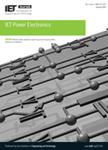版权所有:内蒙古大学图书馆 技术提供:维普资讯• 智图
内蒙古自治区呼和浩特市赛罕区大学西街235号 邮编: 010021

作者机构:Hunan Univ Technol Coll Elect & Informat Engn Zhuzhou Hunan Peoples R China CSG Elect Power Res Inst Co Ltd Guangzhou Guangdong Peoples R China
出 版 物:《IET POWER ELECTRONICS》 (IET Power Electron.)
年 卷 期:2023年第16卷第2期
页 面:305-319页
核心收录:
基 金:National Natural Science Foundation of China Educational Commission of Hunan Province of China [21B0552] Natural Science Foundation of Hunan Province of China [2021JJ30217]
主 题:greedy optimization algorithm permanent magnet synchronous motor Optimisation techniques simulated annealing particle swarm optimization method SOSAPSO evolution dynamic opposition-based learning inertia weight update process multistrategy self-optimizing SAPSO algorithm permanent magnet motors local convergence problems PSO tempering mechanism Cauchy-Gaussian hybrid variation strategy particle swarm optimisation convergence synchronous motors local fine-exploitation capabilities Synchronous machines PMSM parameter identification simulated annealing mathematical analysis full-rank mathematical model fitness function
摘 要:To address the unsatisfactory performance of particle swarm optimization (PSO), a novel multi-strategy self-optimizing simulated annealing particle swarm optimization (SOSAPSO) method for permanent magnet synchronous motor (PMSM) parameter identification is proposed. The full-rank mathematical model and the fitness function are developed. In SOSAPSO, the velocity term of the PSO is simplified and dynamic opposition-based learning (DOBL) is introduced in the inertia weight update process to avoid population monotonicity. Moreover, A Cauchy-Gaussian hybrid variation strategy based on similarity and density is devised to achieve self-learning in deep regions. Meanwhile, the simulated annealing (SA) with a memory and tempering mechanism is introduced into SOSAPSO, and the greedy optimization algorithm (GOA) is used to enhance local fine-exploitation capabilities when SOSAPSO evolution is stalled. The test results indicate the proposed method can effectively avoid local convergence problems and has better robustness and convergence speed.